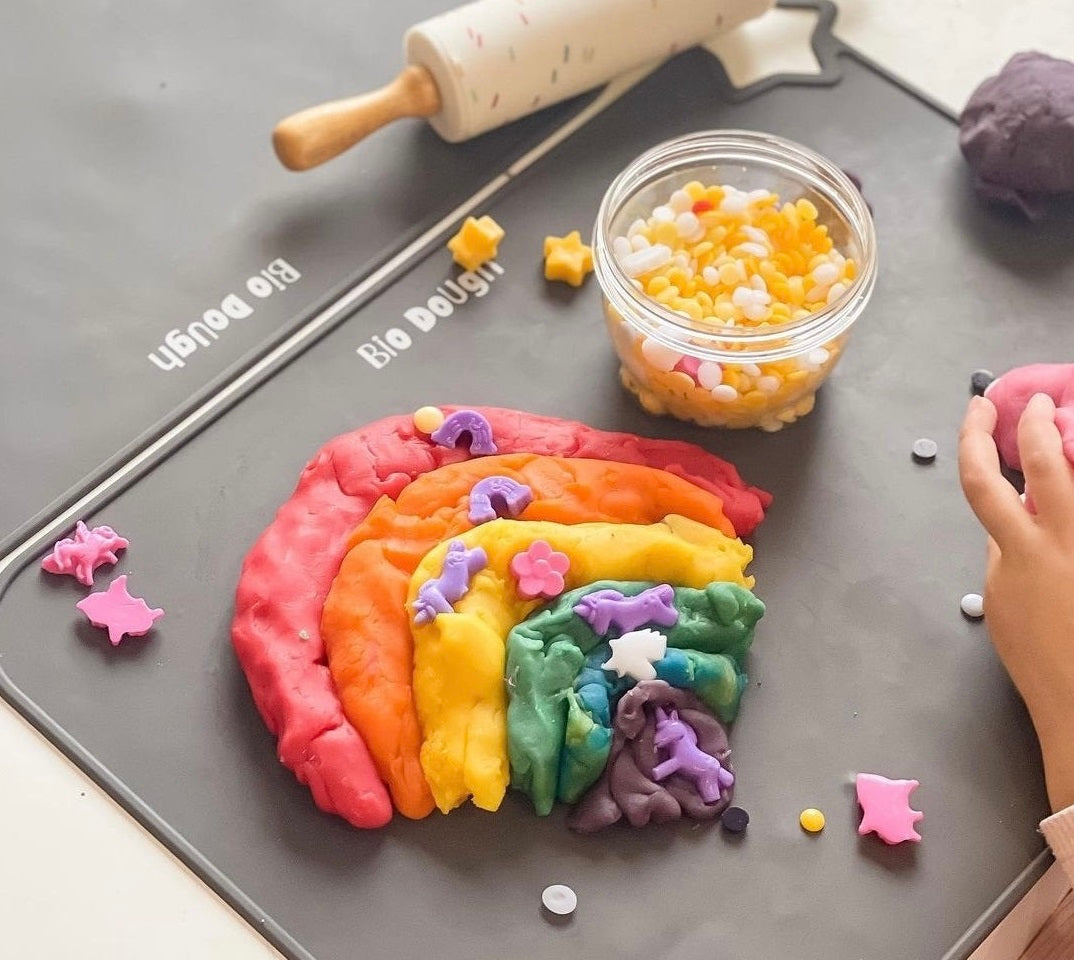When Can Kids Start Using Playdough? A Parent’s Guide to Safe, Creative Play
Playdough isn't just a fun activity it's a developmental powerhouse. From strengthening tiny hand muscles to sparking creativity and language skills, playdough offers endless benefits. But when is the right time to introduce it to your child? And how can you ensure it's safe and engaging at every stage?
In this guide, we’ll explore the ideal ages for introducing playdough, how to adapt it to your child’s developmental stage, and creative ways to make playtime both fun and educational.
👶Toddlers (18–24 months): Introduction to Playdough
Is playdough safe for toddlers aged 18 to 24 months?
At this stage, toddlers are ready to engage more actively with playdough. They may enjoy squishing, rolling, and poking the dough, which are excellent for developing fine motor skills.
How to introduce playdough to toddlers:
-
Supervised play: Always supervise your toddler during play to prevent ingestion
-
Use safe materials: Opt for homemade, non-toxic, and natural playdough to ensure safety.
-
Interactive activities: Guide your child in rolling, squishing, and shaping the dough to enhance motor skills.
Benefits:
-
Fine Motor Development: Actions like rolling and squishing strengthen hand muscles, preparing them for future writing skills.
-
Language Skills: Describing actions and textures during play enhances vocabulary and communication abilities.
-
Imaginative Play: Encourages creativity as toddlers begin to use playdough to represent objects or animals.
Safety Tip: Always use non-toxic, homemade playdough and supervise play to ensure safety.
🧒Preschoolers (3–5 years): Creative and Structured Play
What are some creative playdough activities for preschoolers?
Preschoolers can engage in more structured play with playdough. They can follow simple instructions to create shapes, letters, or animals, enhancing their cognitive and motor skills.
Creative activities:
-
Shape creation: Encourage your child to form basic shapes like circles, squares, and triangles.
-
Letter and number formation: Guide your child in forming letters and numbers to enhance literacy and numeracy skills.
-
Imaginative play: Create stories and scenarios with playdough characters to foster creativity.
Benefits:
- Cognitive Skills: Following instructions and creating specific shapes enhances problem-solving abilities.
- Social Skills: Playing with others fosters sharing, turn-taking, and communication.
-
Creativity: Encourages imaginative play as children create stories and scenarios with their dough creations.
Safety Tip: Ensure all tools used are child-safe and appropriate for their developmental stage.
👦School-Aged Children (6+ years): Advanced Playdough Activities
How can playdough be used in educational settings?
Older children can engage in more complex playdough activities, such as creating detailed models or using playdough in educational projects. This stage allows for the integration of playdough into learning activities, making it a versatile tool for education.
Educational activities:
-
Modeling concepts: Use playdough to represent concepts in science, math, or history, making learning interactive.
-
Detailed creations: Encourage children to create detailed models or sculptures to enhance fine motor skills.
-
Independent projects: Allow children to work independently on playdough projects to foster creativity and problem-solving.
Benefits:
-
Advanced Fine Motor Skills: Detailed work with playdough enhances dexterity and hand-eye coordination.
-
Educational Integration: Use playdough to represent concepts in science, math, or history, making learning interactive.
-
Independent Play: Encourages independent thinking and problem-solving as children work on their creations.
Safety Tip: Ensure that playdough is stored properly to prevent drying out and that all tools are safe for use.
🎨What are some creative playdough activities for kids at Any Age?
Regardless of age, playdough can be adapted to suit various developmental stages and interests. Here are some creative ideas:
- Sensory Bins: Fill a bin with playdough and add safe objects like buttons, beads and Bio DoUgh Sprinkles & Figurines for sensory exploration.
- Alphabet and Number Play: Use playdough to form letters and numbers, aiding in literacy and numeracy skills.
- Storytelling: Create characters and settings with playdough to tell stories, enhancing language and imagination.
-
Texture Exploration: Mix different materials into playdough, like glitter to explore textures and cause-and-effect relationships.
Benefits:
- Sensory Exploration: Enhances sensory processing and awareness.
- Cognitive Development: Stimulates problem-solving and critical thinking skills.
-
Creativity: Encourages imaginative play and storytelling.
Safety Tip: Always supervise children during play to ensure safe exploration.
🧼Safety Tips for Playdough Play
What are the safety precautions for using playdough with children?
Ensuring safety during playdough activities is paramount:
- Supervision: Always supervise children during play to prevent ingestion and ensure safe play.
- Storage: Store playdough in airtight containers to prevent drying out and contamination.
- Allergens: Be mindful of potential allergens in homemade or Store-bought playdough and choose products accordingly.
-
Tools: Use age-appropriate tools and ensure they are safe for children to handle.
Benefits:
- Safe Play: Prevents accidents and ensures a positive play experience.
- Hygiene: Maintains cleanliness and prevents the spread of germs.
-
Longevity: Proper storage extends the life of playdough.
Safety Tip: Regularly inspect playdough and tools for wear and tear, replacing them as necessary.
🏁Conclusion
Introducing playdough at the appropriate age can provide numerous developmental benefits for your child. From sensory exploration in toddlerhood to advanced creative projects in school age, playdough serves as a versatile and engaging tool for learning and development.
Remember to choose safe, non-toxic materials, supervise play, and adapt activities to your child's developmental stage. With these considerations in mind, playdough can be a delightful and educational addition to your child's playtime.


